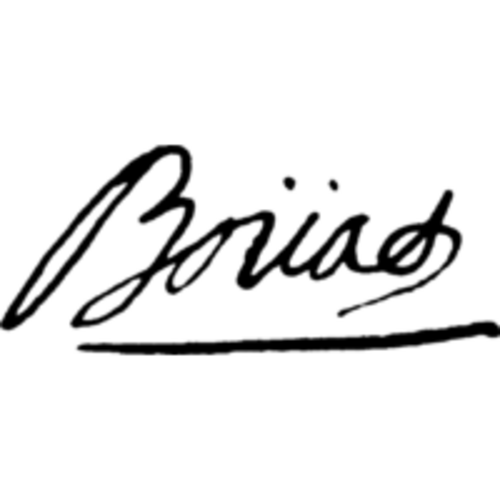
Source: Courtesy of Wikimedia Commons
BOUAT, FRANÇOIS-MARIE, lieutenant general at the court of royal jurisdiction at Montreal, seigneur of Terrebonne and merchant; baptized 25 March 1676 at Montreal, son of Abraham Bouat and Marguerite de Névellet; buried 18 May 1726 in the same town.
Bouat is an example of the type of junior official who did not hesitate to combine the functions of a judge with those of a dealer in furs. The son of a tavern-keeper, he engaged in trade at a very early age, and was convicted in 1695 for trafficking in spirits. Until 1709 he seems to have frequented the main fur-trading routes, particularly those in the pays d’en haut and upper Louisiana. On 20 April 1709 his appointment to the post of lieutenant to the provost marshal of Montreal put an end to his trips into the hinterland, but not to his business affairs. In general, his duties consisted of ensuring public order at Montreal with the aid of archers that were placed at his disposal. In 1711, while retaining his post in the marshalcy, he received a commission as special lieutenant at the court of royal jurisdiction at Montreal, and in that capacity he was required to assist the lieutenant general, Jacques-Alexis de Fleury Deschambault, in his function as royal judge for civil and criminal affairs. Following Deschambault’s death Bouat went to France in 1715, and there succeeded in acquiring for himself the post of lieutenant general, for which he received a commission on 27 April 1716. He was to perform his duties as a royal judge until his death.
This did not mean that Bouat neglected his interest in trade; his pronounced liking for trafficking resulted in his being suspended from office and sentenced by a court martial to a month in prison in 1718, when in contravention of Rigaud de Vaudreuil’s orders he had fitted out three canoes, instead of two, which he intended for Alphonse Tonty, the commandant at Detroit. Claude de Ramezay, the governor of Montreal, informed of the judge’s disobedience before the hired crews set out, had demanded that Bouat conform rigorously to Vaudreuil’s authorization. Bouat carried on without turning a hair. When convicted his only recourse was to the king. He did not fail to avail himself of this by making use of the support of his sister Marguerite, Antoine Pascaud’swife, who was a creditor of Ramezay and who asserted that the governor of Montreal was making this matter a pretext for wreaking vengeance. In June 1720 the king ratified the sentence passed by the court martial, but nevertheless reinstated Judge Bouat in office. The king took the opportunity to reprimand the prevaricator and to affirm that the position he occupied forbad him to trade in any way, either directly or as a middleman. The warning remained a dead letter. There is a document showing that the judge was still engaged in trading in 1724.
Bouat was involved in another incident which pitted Governor Vaudreuil against Intendant Bégon*. Following the fire which had devastated the oldest part of Montreal in 1721, Vaudreuil had ordered then and there that the market should henceforth be held elsewhere, on a site farther to the north; Bouat, who refused to listen to this view, allowed the market to be reopened in the same place. Ramezay attempted to have Vaudreuil’s order carried out, but Bouat went to Quebec and informed Intendant Bégon; the latter, jealous of his prerogatives, decided to renew the ordinance of 1706 that established the site of the market at the original spot. The affair was brought before the council of Marine, which settled the dispute in favour of the intendant and thereby allowed Bouat to crow in triumph.
On 1 Oct. 1718 Judge Bouat undertook to purchase the seigneury of Terrebonne, by virtue of a contract signed with Marie-Catherine de Saint-Georges, Louis Le Conte Dupré’s widow. But he kept it only two years: on 12 Sept. 1720 he sold it again to Louis Lepage* de Sainte-Claire, the parish priest of Île Jésus, whose name has remained linked with the first efforts at establishing Canadian industry.
On 18 May 1726 François-Marie Bouat was buried at Montreal. On 7 June 1700, at Quebec, he had first married Madeleine Lambert Dumont, daughter of Eustache Lambert Dumont, and Sophie Vanneck. By this marriage he had 13 children, 7 of whom survived their mother, who died in December 1722. Eight months later, on 8 Aug. 1723, he married Agathe Legardeur de Repentigny, who bore him two children.
AJM, Greffe de Pierre Raimbault, 1 oct. 1718, 12 sept. 1720. P.-G. Roy, Inv. concessions, III, 116–22. Godbout, “Nos ancêtres,” APQ Rapport, 1959–60, 284f. É.-Z. Massicotte, “La famille Bouat,” BRH, XXX (1924), 39–45, 198, 409; “Les juges de Montréal sous le régime français, 1648–1760,” BRH, XXVII (1921), 181; “La maréchaussée à Montréal,” BRH, XXII (1916), 16–18.
Cite This Article
Jean Blain, “BOUAT, FRANÇOIS-MARIE,” in Dictionary of Canadian Biography, vol. 2, University of Toronto/Université Laval, 2003–, accessed April 26, 2025, https://www.biographi.ca/en/bio/bouat_francois_marie_2E.html.
The citation above shows the format for footnotes and endnotes according to the Chicago manual of style (16th edition). Information to be used in other citation formats:
| Permalink: | https://www.biographi.ca/en/bio/bouat_francois_marie_2E.html |
| Author of Article: | Jean Blain |
| Title of Article: | BOUAT, FRANÇOIS-MARIE |
| Publication Name: | Dictionary of Canadian Biography, vol. 2 |
| Publisher: | University of Toronto/Université Laval |
| Year of publication: | 1969 |
| Year of revision: | 1982 |
| Access Date: | April 26, 2025 |



